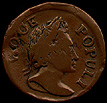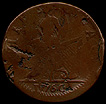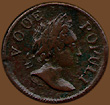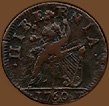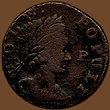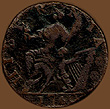Voce Populi Coppers 1760
obverse |
|
reverse |
| |||
1760 Zelinka 7-E Voce Populi Copper
Obverse: VOCE POPULI
Reverse: [.] HIBE R NIA . 1760
Weight: 109.3 g (7.08 grams) Diameter: 25.7 mm
Comments: Nelson 3. The obverse legend is without punctuation. It is an early state of the die for the c is not fully closed. This die cracked so that several coins were produced with a closed c, known as the VOOE variety. Even in this worn example with several planchet voids on the reverse the variety can be distinguised by the harp strings. In die E the two longers strings are very close together.
Provenance: Donated to Notre Dame in 1887 as part of a 2,300 item coin collection (see: The Notre Dame Scholastic, vol. 21 (September 1887) 45.
obverse |
|
reverse |
| |||
1760 Zelinka 7-E Voce Populi Copper
Obverse: VOCE x POPULI
Reverse: . HIBE R NIA . 1760
Weight: 100.0 g (6.47 grams) Diameter: 28.3 mm
Comments: Nelson 3. On the obverse in this example the die break in the c is complete to give VOOE (see the preceeding example for an earlier state). However in this example the punctuation in the legend differs from the norm. According to Zelinka this variety is without punctuation as is evident in the preceeding example. However on this obverse there appears to be a design in the shape of an X after VOOE at about 12:00 o'clock. I did not notice this design until I did the scan of the coin for the surface is dark and somewhat porous. The reverse shows the eight string harp. In this variety the two longest strings are very close together. Also the lower right frame of the harp has designs, below is a ring and further up is a dot.
Provenance: From the Robert H. Gore, Jr. Numismatic Collection.
obverse |
|
reverse |
| |||
1760 Zelinka 15-N Voce Populi Copper
Obverse: VOCE . POPULI
Reverse: HIBER N IA [two rosettes] 1760
Weight: 94.3 g (6.11 grams) Diameter: 27.4 mm
Comments: Nelson 12. The obverse has what is called the long head bust similar to that used for die 14. In die 15 the I is much further from the bust and there is a prominant P in the open field just to the right of the face. The significance of the P is unknown. It is also found on die 16 where it is located below the shoulder of the bust. The reverse includes two rosettes after the legend and has a harp with only six strings. Acooriding to Zelinka the lower right frame of the harp is decorated with two rings, however the area is worn on this example.
Provenance: Donated to Notre Dame in 1887 as part of a 2,300 item coin collection (see: The Notre Dame Scholastic, vol. 21 (September 1887) 45.
| Voce Populi Coppers: p.1 | Section Contents | William Pitt Tokens |
|
For viewing tips and information on optimal computer settings click
here.
For questions or comments contact Special Collections by: |
